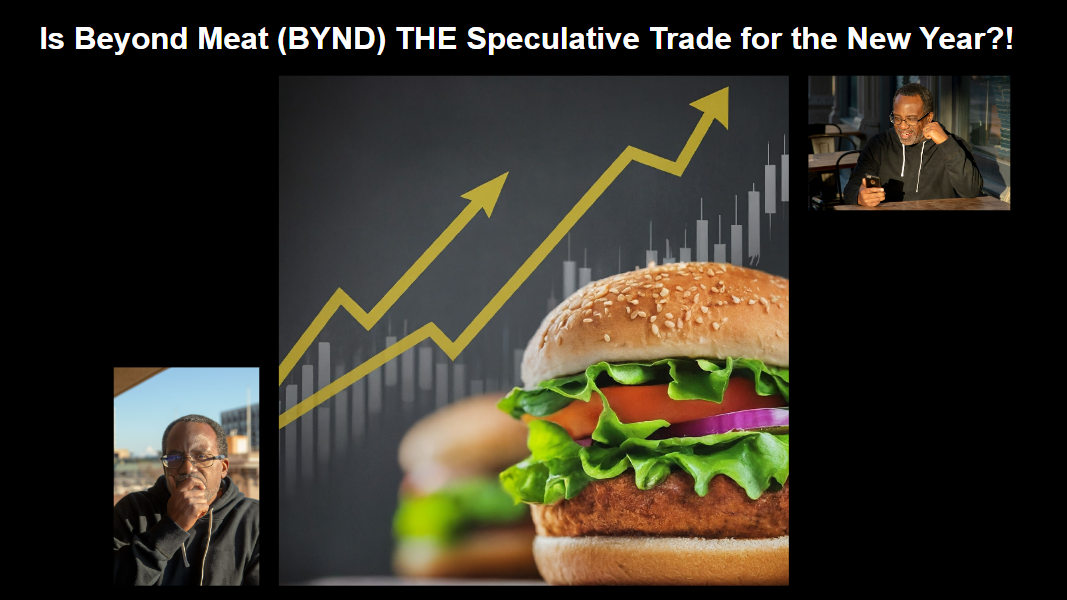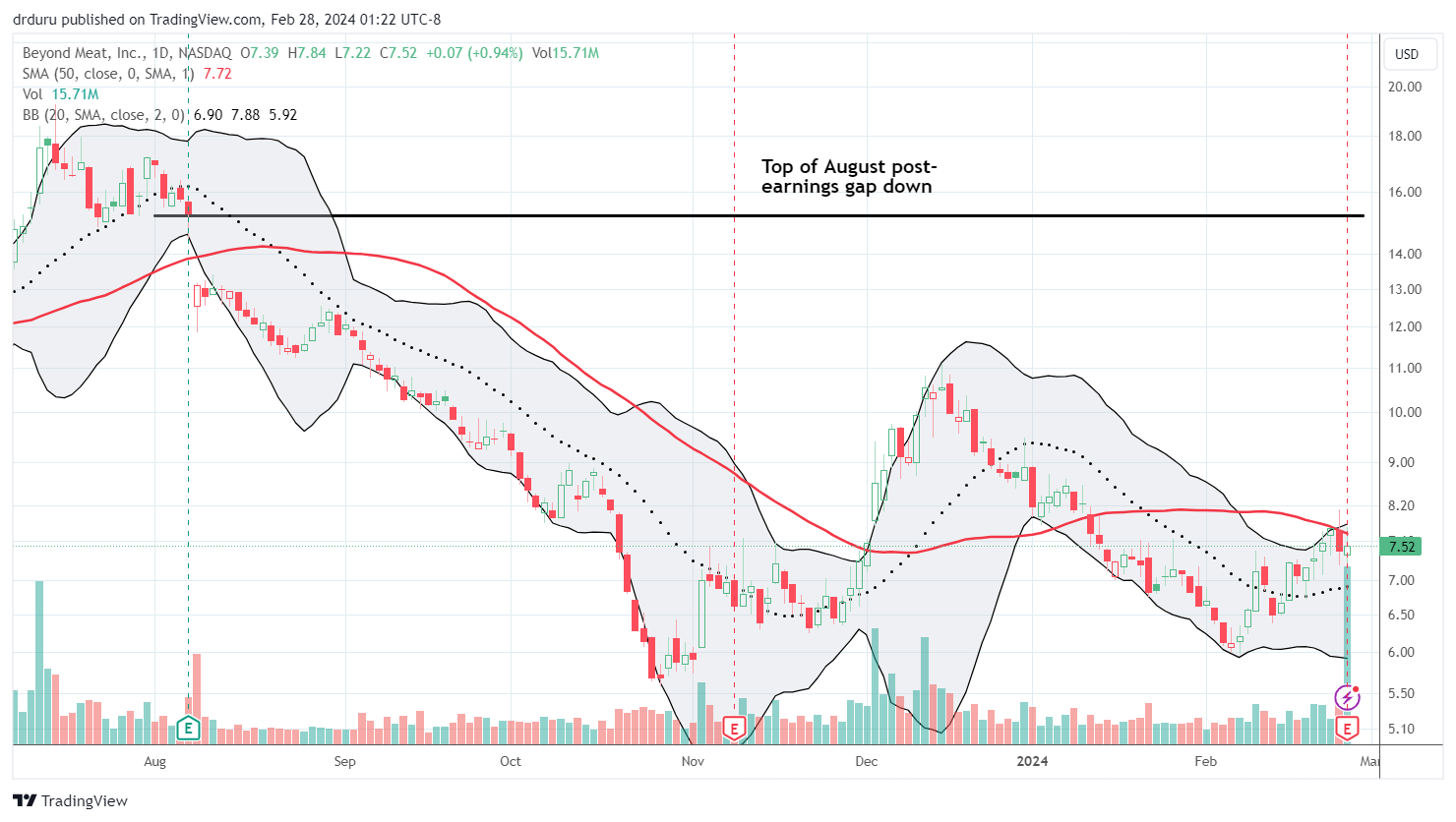Sometimes it pays to be stubborn. In December, I asked whether Beyond Meat (BYND) would be the speculative trade of the new year. I presented a simple thesis that managed to work out. However, the path from A to B was totally unexpected, and I broke rules along the way. In response to earnings, BYND soared 76% in after hours trading. According to CNBC’s Fast Money, the stock almost doubled at its after hours highs. If so, BYND meet exactly tapped my trade target of a close of the August, 2023 post-earnings gap down (pay attention to price levels!). I closed out my position short of that target at $13.45. I also learned some important lessons.
Breaking the Rules On A Busted Beyond Meat Trade
Excluding the first week, the new year started with a buying fury that BYND refused to join. I lamented how BYND wilted the last two weeks of December, effectively meaning I made the case for BYND right at a price top. Still, I followed my plan to accumulate stock to support at the 50-day moving average (DMA). That accumulation increased my bond to the position. So when BYND closed below 50DMA support, I failed to trigger a stop-loss. I broke my trading rule to get out of the position on a violation of a key technical level.
Instead, I acknowledged the trade could be a bust, but I was willing to wait out earnings (in the comments of the related trade video). In other words, I managed to size the position so that I could wait out the loss. I waited to see whether earnings could deliver the catalyst I expected weeks before.
The Case for Re-Entering the Beyond Meat Trade
Even if I had exited the trade, I could have made a fresh case for re-entering the trade before earnings based on price levels. The selling in BYND stopped on a dime right at the stock’s launching point ahead of the November 2nd 18.4% surge. That day bulls exploded out of oversold conditions and created the big push that continues to endure. So based on price levels, the end of selling at that point provided a fresh buying signal…this time a bottom-fishing signal. I did not take the bait because I felt like I already owned enough shares.
A subsequent 20DMA breakout validated the bottoming action. However, new buyers would have been hard pressed to sit on profits with BYND stalling right at 50DMA resistance ahead of earnings! For an “older” buyer like me, I had made it that far so it made little sense to bail at the moment of truth.
What Did Beyond Meat Deliver for Earnings?
I asked ChatGPT to provide a buying case for BYND based on the transcript of the earnings conference call. I also asked for risks to the buying case:
The case for buying Beyond Meat
- Strategic Shifts for Efficiency and Growth: Beyond Meat has implemented strategic shifts towards more efficient operations and a leaner structure, with a focus on sustainable growth. This includes a reduction in operating expenses and a significant cut in their operating budget for 2024.
- Innovative Product Developments: The introduction of Beyond IV, a new product platform, demonstrates Beyond Meat’s commitment to innovation. This product is expected to offer superior nutritional and sensory outcomes, which could enhance brand appeal and drive sales.
- Expanding International Presence: Beyond Meat continues to invest in its European business and has seen continued traction with strategic customers, including McDonald’s across several countries. This international expansion could open new revenue streams.
- Cost Reduction and Margin Expansion: The company is implementing pricing changes to support gross margin expansion and has successfully consolidated its production network, which is expected to contribute significantly to margin improvement.
- Strategic Partnerships and Distribution: Beyond Meat maintains strategic partnerships and distribution channels that could facilitate growth, especially as it plans to roll out its new Beyond IV product in U.S. retail.
This nifty summary aligned with the summary I heard on CNBC’s Fast Money, so I consider it sufficient.
The risks to the buying case
- Market Competition and Price Sensitivity: The plant-based meat industry is highly competitive, and Beyond Meat faces challenges related to price sensitivity among consumers, especially with planned pricing changes.
- Consumer Perception and Health Claims: The success of new product launches, like Beyond IV, relies on changing consumer perceptions around the health benefits of plant-based meats. Misinformation and competitive pressures could impact market reception.
- Operational Efficiency and Cost Management: While the company has made strides in reducing costs and improving efficiency, continued vigilance in cost management and operational execution is critical to achieving profitability.
- Regulatory and Market Risks: Beyond Meat operates in a rapidly evolving industry that could be subject to regulatory changes, market dynamics, and shifts in consumer preferences that may impact its growth trajectory and profitability.
These risks are generic and not organic to the content of the transcript. Still, they make sense. Point taken, ChatGPT.
I lastly asked ChatGPT to limit its risk assessment to the content of the transcript. It found a host of concerns expressed by analysts:
- Pricing Strategy and Elasticity Concerns: Analysts expressed concerns about Beyond Meat’s new pricing strategy, questioning the potential impact on consumer demand, especially given the price sensitivity in the plant-based meat category. The introduction of price increases could potentially lead to volume declines if consumers are not willing to absorb the higher costs.
- U.S. Market Challenges: There were questions about Beyond Meat’s ability to re-attract lapsed consumers in the U.S. market, where category growth has slowed, and the brand has faced challenges. Analysts were curious about strategies to address declining trends and how Beyond Meat plans to convince consumers to return to the brand amidst wider price gaps with animal meat products.
- Operational Efficiency and Cost Reduction: While Beyond Meat has implemented significant cost-cutting measures and operational efficiencies, analysts inquired about the sustainability of these efforts and their impact on gross margins. Concerns were raised about the reliance on these measures for improving financial performance and whether they would be sufficient to drive profitability.
- Gross Margin Improvement: Questions were raised about the drivers behind the projected improvement in gross margins, particularly the extent to which price increases versus operational efficiencies would contribute. There was a focus on understanding the balance between pricing actions and volume growth, and how these factors would impact the company’s financial health.
- International Expansion and Profit Margins: Analysts questioned the profit margin profile of Beyond Meat’s international operations, especially given the shift towards more international sales. There were concerns about whether international markets would be as profitable as the domestic market, considering different competitive dynamics and consumer preferences.
- Product Portfolio and Distribution Adjustments: The decision to discontinue certain product lines, such as Beyond Meat Jerky, raised questions about the impact on distribution and overall sales. Analysts were interested in how these adjustments would affect the company’s presence in various retail and food service channels.
- Cash Burn and Liquidity: With significant non-cash charges and ongoing operational expenses, there were concerns about Beyond Meat’s cash burn rate and liquidity. Analysts sought clarity on the company’s plans to manage cash flow and ensure sufficient liquidity to support operations and growth initiatives.
Frankly, after reading this summary of risks and concerns, I am even MORE startled BYND was able to double after this earnings report!
Trading Lessons
My (original) technical case on BYND failed. The “January effect” failed to help BYND. My case against “greedy bears” who created an overcrowded short was likely spot on. Yet, I was not counting on a sharp short squeeze to deliver my price target. In my head, BYND would survive tests of 50DMA support on its way to a months-long path to fill the August post-earnings gap down.
Thus, the lesson I take from this successful trade is to think AHEAD more thoroughly about alternative paths to the completion of a trading hypothesis. Doing such a comprehensive analysis will then not leave me feeling like a rule breaker when I make exceptions that happen to win out in the end. In other words, I do not want to learn that breaking trading rules pays! I accept in this case I made a fortuitous pivot.
Be careful out there!
Full disclosure: no positions



Your narrative of profitable rule-breaking reminded me that I once inadvertently let a long put expire in the money, leaving me with a short position. The stock gapped down the following Monday, but since I had never intended to be short the stock I covered immediately, at a profit that washed out what I’d lost on the put. A few months later the company went bankrupt. In theory, I left an enormous profit on the table. How many mistakes did I make?
My answer is, two:
1) On Friday, I failed to execute my original low-risk/low-profit plan, e.g. selling the put at a small profit before expiration
2) On Monday, I reflexively de-risked rather than thinking through the new situation
In hindsight a good move Monday would have been to buy an at-the-money call, which would have (a) locked in some profit; (b) bounded the risk on the short position; and (c) bought me time to properly evaluate the risk/reward of continuing to carry some or all of the short position.
I’m curious what you and/or your readers think of this analysis.
Assuming you bought the put because you sniffed trouble, then (in hindsight), you indeed could have reevaluated the situation. However, since you did not use your profits to buy another put option, I suspect you only thought of the trade as a very short-term play. Given that assumption, I cannot imagine what would have motivated you to roll into a new trade. If I had an overall negative opinion of the company, I would have planned the next trade…and make sure I kept a close eye on expiration!
I have closed several trades where I realized afterward I should have instead let the trade ride and locked in profits with an opposing call option. The closest I ever come is locking in enough profits to pay for the position and then ride the house’s money.
In essence, the trade was based on sniffing long-term trouble, and believing the market would sniff what I sniffed in the current week (the put had 5 days of life left when I bought it). That’s exactly what played out, but only slowly, so the put didn’t quite hit my profit target and I lost track of it. The gap down the following week was a continuation of the market discovering the trouble. In hindsight, the company was not closely followed.
Thanks for the additional info. So you had too much confidence in the market’s olfactory nerves…. 🙂 That’s a fine needle to thread: finding an opportunity that the market has not sniffed out so the puts are cheap but setting the expiration far enough out for the market’s “efficiency” to finally kick in!